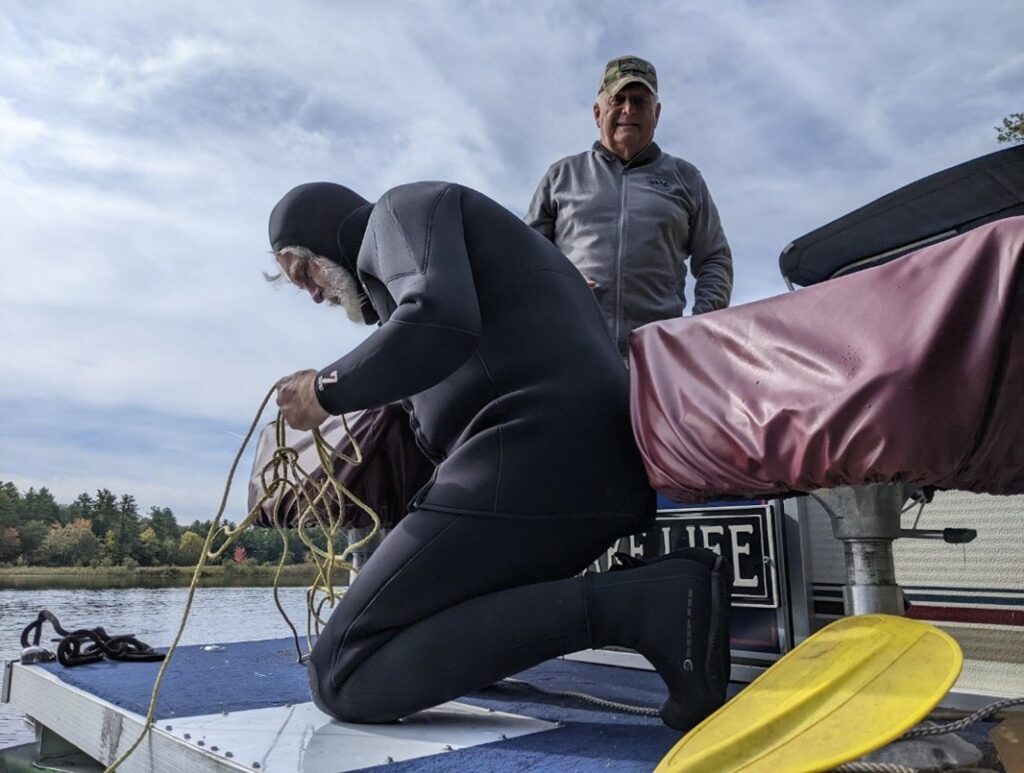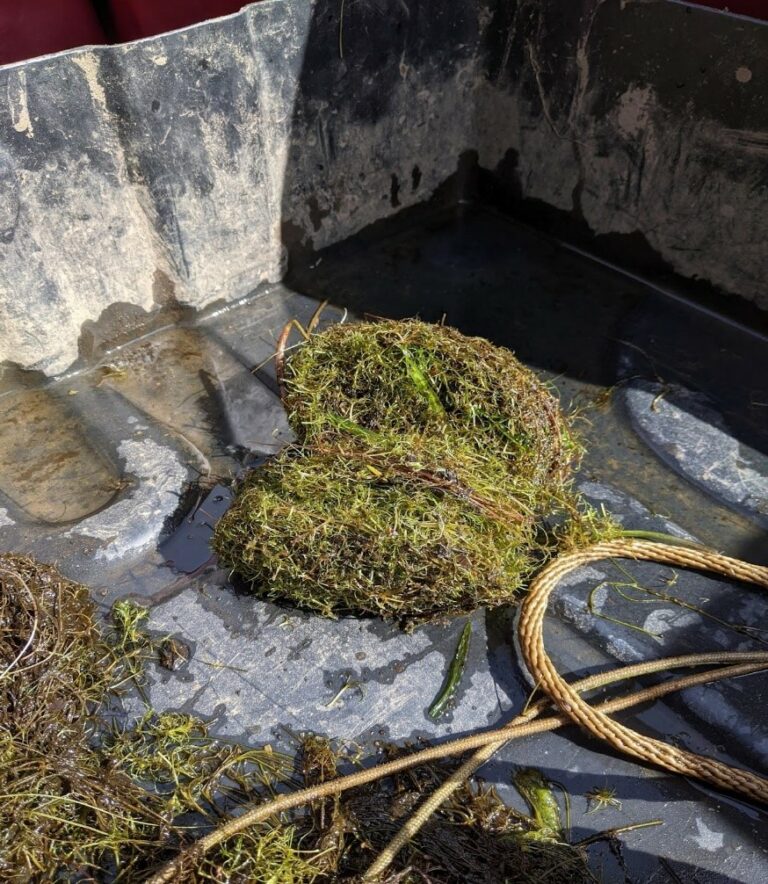Naiad Update, Oct 2022 by Debbie Broderick
Our 2022 Brittle naiad (Najas minor) harvesting season using DASH teams came to an abrupt end on August 31 this year due to staffing shortages. I continued surveying the dam section of the lake by kayak, and my husband and I removed the plants we could reach using snorkels and nets. Each time I surveyed the same areas, I found more plants, even after previous removal – finding them is tricky, and depends on light, depth and surface water conditions.
Towards the end of September, I was reminded by some residents that naiad fragments had been found floating along the shoreline between beaches 11 and 12, of the Brown Brook arm. Previous surveys had not turned up any plants growing in that section of the lake, so an updated survey was needed.
On my traverse, I found scattered plants growing all along the shore, as well as between the islands separating the Brown Brook arm from the dam section of the lake. I marked the locations in red. I didn’t find any in the wetlands and marshy areas (brown sections in this photo). Other residents in this area have since reported finding naiads growing along their shore.
This is an important development: it is an expansion of the area populated by naiads in our lake.

Some of these plants were densely packed together, and I was unable to remove them safely from my kayak. On September 30, Dave Sanfason, Dale Schultz and I worked together to remove them. Dale dived and carefully removed the hedge in segments with a net, while I scooped up fragments from the surface in my kayak.
Here are a few photos from the removal operation.



This past fall of 2020, Brittle Naiad was found in Lake Arrowhead by LAC lakefront owner Deb Broderick. Once identified, a series of activities immediately kicked off. The DEP contacted LACC leadership and working with various lake organizations a Plant Patrol Survey of the Lake was identified leading to the displayed map which contains identified locations of Naiad. Once identified, LACC requested and became the beneficiaries of the DEP’s Rapid Response Program. Divers and a Harvester from a DEP contracted organization worked with LACC DASH divers and began harvesting at the area identified as the “mother colony” of the Naiad plant.
LACC will begin working the Spring of 2021 with a modified basket on the harvester to remove the documented areas of Naiad on the map.

Featured Video
Dale Schultz
Low-tech technique for the removal of the invasive aquatic plant Najas minor, also known as European Naiad, Brittle Waternymph or Spiny Naiad. The annual plant is very brittle and has to be removed very gently so as not to let fragments float away carrying the seeds. This can be achieved by a snorkeler using a sturdy landing net with holes no bigger than 1/8″. If you think you may have this Naiad plant in your lake, contact the Lake Stewards of Maine. https://www.lakestewardsofmaine.org/ Filmed at Lake Arrowhead, Maine. Plant removal done with the permission of Maine DEP. Music by Bill Grundmann/SmokeyVW used with permission.

A suspicious plant was found in Lake Arrowhead by Invasive Plant Patroller and lake resident Debbie Broderick during the weekend of Aug. 22nd. Debbie sent the plant to Roberta Hill at Lake Stewards of Maine (LSM) who confirmed, after conferring with a group of experienced taxonomists in the northeast, that the plant is Najas minor or brittle naiad (also called brittle waternymph).
This is the second invasive aquatic plant in Lake Arrowhead and third location for this plant in Maine. Brittle naiad is a prolific seed producer and with high spread potential because the seeds are very small and may be concealed on boats, gear, and clothing. The seeds can also survive ingestion by waterfowl and may be moved by their activity.
| Brittle Naiad Photo: Debbie Broderick |
 Immediately after hearing the confirmation, Laurie Callahan of the York County Invasive Aquatic Species Project rallied volunteers to survey three days on Arrowhead (Aug. 31st, Sept. 3rd and 8th); another day of surveying is planned for this month. This has been an extremely rapid and well-organized response involving 11 volunteer plant surveyors. Their surveying was critical for directing a day of removal by New England Milfoil (NEM) on September 4th. DEP hired NEM, which has extensive experience removing this plant in the Salmon Falls River on the ME/NH border, under a contract for rapid response to new infestations.
Immediately after hearing the confirmation, Laurie Callahan of the York County Invasive Aquatic Species Project rallied volunteers to survey three days on Arrowhead (Aug. 31st, Sept. 3rd and 8th); another day of surveying is planned for this month. This has been an extremely rapid and well-organized response involving 11 volunteer plant surveyors. Their surveying was critical for directing a day of removal by New England Milfoil (NEM) on September 4th. DEP hired NEM, which has extensive experience removing this plant in the Salmon Falls River on the ME/NH border, under a contract for rapid response to new infestations.
New England Milfoil removing Naiad near the boat ramp.
Photo: Dale Schultz

The Lake Arrowhead Conservation Council (LACC) diver-assisted suction harvest (DASH) team located the largest patch of this new invader and observed NEM’s work on the 4th. Debbie and her husband Dale Shultz, the LACC DASH crew and DEP collected fragments during NEM’s removal. The LACC DASH crew, which has extensive experience managing variable-leaved water-milfoil, is poised to modify their collection equipment to deal with the small fragments created by brittle naiad in the coming years.
Brittle Naiad from the surface
Photo: Dale Schultz
Everyone’s hope is that the infestation is confined to one part of the lake and can be managed with manual removal, but time and additional surveying will tell. While the new find is clearly bad news, the rapid response by local and regional groups has been phenomenal.
E-mail from Laurie Callahan of YCIASP.
Some of the sessions were in September in response to a request from John McPhedran of ME DEP.
In September, European naiad (Najas minor) was found at Lake Arrowhead in Limerick by newly trained IPP volunteers Debbie Broderick and Dale Schultz. John M. asked me if I could do some surveying for the plant at the lake and I invited several volunteers to join me for 4 surveying events during mid-September. Most all of those volunteers had seen European naiad “in situ” before – at Milton 3 Ponds or at Spaulding Pond during recent years. Debbie and Dale were also part of the survey team.
After the survey sessions were done, I also offered a European naiad “tour” at Lake Arrowhead to IPP team leaders in York County. Debbie and Dale were able to co-lead that session with me. A few team leaders were able to join us for that educational session in late September.
Below are 3 articles and a webinar related to that new European naiad discovery at Lake Arrowhead that were published or held this past fall. There are links provided to those, except one article in the LEA CBI September Newsletter, which I will send as a separate email.
European naiad seems to be a species that has been appearing in waterbodies in southern NH and ME in recent years. Like other invasive aquatic plants, it is a species that is important to detect as early as possible – particularly because it is an annual plant that produces numerous tiny seeds and disperses them very efficiently and broadly.
To learn more about European naiad or European water nymph – also known as brittle naiad or brittle water nymph, or spiny naiad or spiny water nymph, or simply as Najas minor – please check-out the resources listed below. Feel free to share this info with your IPP team members, association board members and others that might be interested.
I will be sending another update about 2020 and 2021 YCIASP in the next week or two.
Take care and stay healthy!
Laurie Callahan
YCIASP, Founder & Coordinator
******************************************************************************************
-
- Debbie Brodericks’s article in the 9/17/20 Waterboro Reporter (page 6) about European waternymph* at Lake Arrowhead this past September (* also known as European naiad, brittle naiad, brittle water nymph, spiny naiad and Najas minor) – http://waterbororeporter.com/IMAGES_reporter/REP_9-17-20.pdf?fbclid=IwAR0BB_IXsNufOg3zYlPydmNwLDZyMGlRgPP8u9_R2qP8PWvR6uK_kgTRjOw
- Lakes Environmental Association (LEA), Courtesy Boat Inspection Newsletter, September 2020, “Brittle Naiad (waternymph) in Lake Arrowhead” (3rd article) – LC will forward the Sep. 2020 CBI Newsletter from May Jewett, LEA, as a separate email.
- Lake Stewards of Maine, The Water Column, Winter 2020-21, Maine’s Lake Community Comes Together to Address New Invader in Lake Arrowhead, article on page 10 by Debbie Broderick. Also, a related article on page 11, by Dale Schultz – https://www.lakestewardsofmaine.org/wp-content/uploads/2021/02/LSM-tWC-2020-21-WebR2.pdf
- Lake Stewards of Maine (LSM) and Maine Dept. of Environmental Protection (MDEP), video recording of an online presentation given on Sep. 28, 2020, The Hunt for Invasive Naiad in Lake Arrowhead & How You Can Help – https://vimeo.com/462718636/1eca008e23. This was a session presented by John McPhedran (MEDEP) and Roberta Hill (LSM), with guest speakers Debbie Broderick & Dale Schultz of Lake Arrowhead. Description: Spiny naiad (Najas minor) just recently confirmed in Lake Arrowhead in York County. This session will include what is currently known about the extent of spread in these lakes; the biology and typical habitat of Najas minor; the key features by which Najas minor may be positively identified; how to distinguish each from a host of native look alike plants; and importantly, what to do if one finds any suspicious aquatic plants while out on the water.
Click on any image to view a larger image and advance forward or backwards in the album.
Najas minor grows in dense clusters and has highly branched stems. These stems fragment easily and this plant is capable of propagation from stem fragments or from small seeds which grow along its stem. The small flowers are located in clusters along the leaf axils. The leaves of the plant are opposite, unbranched, strap-shaped, and are around 4.5 centimeters in length. The leaves have serrations which are visible to the naked eye. This plant is similar in morphology to coontail or slender naiad.






















